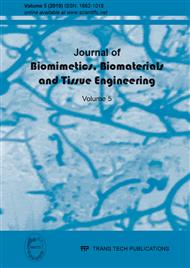p.1
p.13
p.31
p.39
p.57
In Vitro and In Vivo Evaluation of a Calcium Phosphate and Demineralized Bone Matrix Composite Biomaterial
Abstract:
A new class of osteoconductive and osteoinductive combination biomaterials composed of calcium phosphate cement (CPC), demineralized bone matrix (DBM) and a water-soluble viscosity modifier were prepared and characterized in-vitro and in-vivo. In previous studies, a range of combinations formulations were tested in order to compare their performance characteristic. In-vitro characterization results show that the mechanical strength is decreased when the amount of DBM increases. However, DBM does not affect the CPC’s ability to set hard and convert to nanocrystalline apatitic calcium phosphate, which shares the chemical structure of natural bone as seen in x-ray diffraction. It is known that the DBM alone is osteoinductive. In-vivo osteoinductivity testing of the formulations in an intramuscular, athymic rat model demonstrated that the combination material is also osteoinductive. Two formulations were chosen for in-vivo efficacy testing based on the results of in-vitro and in-vivo characterization. These formulations were studied using rabbit critical-sized femoral core defect model. The formulations were composed of DBM with particle sizes of 250 to 710 μm, carboxymethyl-cellulose (CMC) as the viscosity modifier and weight percent compositions of 50% DBM/ 45% CPC/ 5% CMC and 60% DBM/ 30% CPC/ 10% CMC. Bone integration and healing was graded at 6, 12, and 24 weeks. The two formulations were compared to the gold standard autograft at 12 weeks and to an empty defect as the negative control at 24 weeks. Based on micro-computed topography (μCT), both formulations allowed for continuity of bone throughout the defect region at all time points. No differences in dense area fraction were seen between two formulations at 6 weeks (p = 0.8661). There was no significant statistical difference between the two formulations and autograft at 12 weeks (p = 0.2467). At 24 weeks, both formulations had significantly higher dense area fractions than empty controls (p = 0.0001). Histologically, the biology of the treatment areas appeared to have returned to normal by 24 weeks with CPC appearing to be the principal osteogenic inducer. In conclusion, these combinations of CPC and DBM offers significant advantages (handling, mechanical properties and osteoinductivity) over current DBM products and can be an effective alternative to autograft in healing of bone defects.
Info:
Periodical:
Pages:
1-12
Citation:
Online since:
February 2010
Authors:
Price:
Сopyright:
© 2010 Trans Tech Publications Ltd. All Rights Reserved
Share:
Citation:


